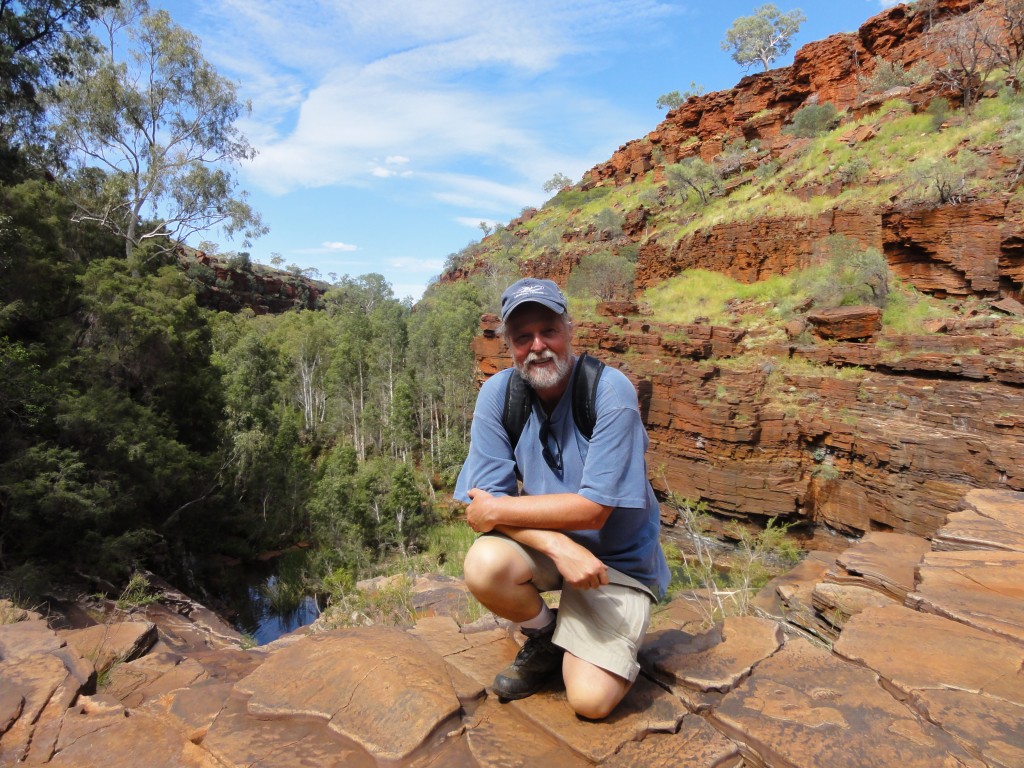Jim sent this post a couple weeks ago, during a monthlong visit to Australia to see his brother and new rocks:
My brother flew back to Perth and left me with the car. I drove to Exmouth–Cape Range Nat’l Park/Ningaloo Marine Park. That area was quite interesting–and would have lots of interest to a carbonate sedimentologist. The backbone of the Cape Range Peninsula is formed by Miocene reef carbonates. These rocks are highly fossiliferous. I spent an extra day there–as I had a bit of mishap with my brother’s car–I trashed a tire (and rim) when I hit a jagged edge of curb in Carnarvon. My brother’s car is a small Hyundai–and two tire places didn’t have a rim. I had to “chance” the drive to Exmouth (without a spare–a bit scary in Australia–as it is so empty–and distances are far). Even there–they had to fly up a rim from Perth–but luckily it arrived the next day. So I spent the time in the national park–and did some snorkeling. That turns out to be some of the best snorkeling I have ever done. The (fringing) reef there is relatively near the shoreline–so you can snorkel from shore. And the turquoise water was bathtub warm–nice!!
After getting my tire repaired–I drove north and into the Hammersley Basin in the Pilbara–to Tom Price (an iron mining town). Once I got into the Pilbara proper the scenery started to change–from the relatively flat and sparse coastal region–into an area that actually had some relief–and outcrops! The Hammersley Basin rocks are folded into a series of basin/dome structures–and driving through that region reminded me of driving Rocky Mtn basin country–with hogbacks and other “structure” related geomorphology–the big difference being the age of the rocks (Paleoproterozoic vs. Mesozoic/Paleozoic rocks of the Rocky Mtn basin margins). We’ll need to see if we can get hold of landsat images from this region. (I haven’t checked GoogleEarth yet–but I’m guessing these structures will show up well on that). I did pick up a nice geologic map of the Pilbara that we can display when we get back. I think I can make use of that for structure (and you might find it useful for Evo).
Tom Price lies outside Karajini National Park–with is all essentially in theHammersley Range. It is most known (at least to non-geologists) for its spectacular gorges cut into BIF. Everything here is tinged with red (reminiscent of my growing up on the MN Iron Range–except that there is relief here–all in Hammersley Group rocks). I think the thing that impressed me the most was the enormous volume of BIF in this country. You can’t get that sense from pictures or verbal description.
I had hoped to go further north into the granite/greenstone terrane–but a lot of that was really only accessible by 4WD–and would have taken another three days minimum. And lodging is scarce (and expensive where available). But I got to see the Hammersley–which was my primary goal. I ended up making the trip back in a 14 hour drive–and crossed into the Yilgarn craton–though the Murchison goldfields. (I have been to the Kalgoorlie goldfields–farther south–and west of Perth–in 2000). There some rock exposures–mainly of highly altered rocks in the “goldfield” area. Otherwise the terrane was pretty flat–with a little granite cropping out here and there.
We actually had a cool front move through last night–and a few drops of rain–the first we have had since I arrived in Perth. (It looks like the temps will remain in the 20’s (C) for the next week anyway–rather than the 30’s (highs) which have been pretty consistent since I arrived.
Cheers,
Jim
